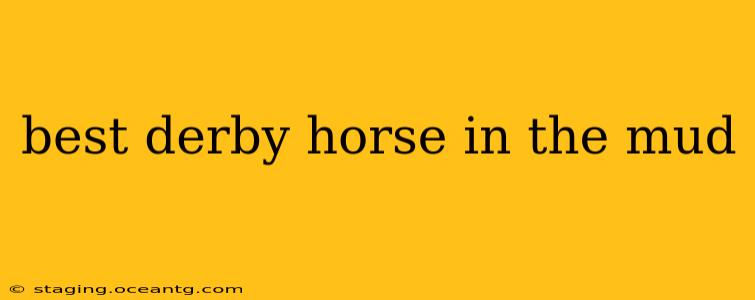The Kentucky Derby, the most exciting two minutes in sports, is often unpredictable. But one factor that can dramatically shift the odds is the track condition. A muddy track, often caused by heavy rain, creates a completely different playing field, favoring horses with specific characteristics. So, who are the best Derby horses in the mud? It's not a simple answer, but let's delve into the traits that make a mudder champion and explore some legendary examples.
What Makes a Great Mudder in the Kentucky Derby?
Several factors contribute to a horse's success on a sloppy track:
-
Powerful Stride: Mud adds significant resistance, requiring horses to expend more energy with each stride. A powerful, efficient stride is crucial for overcoming this extra resistance. Horses with a longer stride often have an advantage.
-
Leg Action and Conformation: The mud can cause a horse to lose its footing, so strong leg action and proper conformation (the structure of the horse's legs and body) are critical for maintaining balance and traction. Think strong, well-muscled legs and feet that can effectively churn through the mud.
-
Stamina and Heart: Racing in the mud is incredibly demanding. Horses need exceptional stamina to sustain their effort over the long distance. A "big heart" – the willingness to dig deep and push through adversity – is equally important.
-
Experience in Muddy Conditions: A horse's prior experience racing on sloppy tracks is a significant indicator of future performance. Horses who've proven themselves in muddy conditions are more likely to succeed again.
Which Derby Horses Excelled in the Mud?
While definitive lists are subjective, certain horses have etched their names in history as mud-loving champions. Analyzing their performances reveals common themes that align with the characteristics discussed above:
-
Secretariat (1973): Though known for his incredible speed on fast tracks, Secretariat also demonstrated his prowess in the mud, winning the Belmont Stakes on a sloppy track. His exceptional power and stamina clearly shone through even in challenging conditions.
-
Affirmed (1978): A three-time Triple Crown winner, Affirmed showcased his versatility by performing well in various track conditions. While not exclusively known as a mudder, his consistent performance across different surfaces highlights his exceptional athleticism.
-
Seattle Slew (1977): Another Triple Crown winner, Seattle Slew had the reputation of a reliable performer even on less-than-ideal surfaces. His power and stamina were key to his victories.
Many other Derby horses have performed admirably in muddy conditions, but identifying the best is nearly impossible without a more specific criteria (e.g., muddiest Derby in history). Analyzing individual races and horses' form in those specific conditions is a better approach for a definitive answer.
H2: What are the different types of mud in horse racing?
The consistency of the mud significantly affects a horse's performance. While there isn't an official classification system, track conditions are often described using terms like "sloppy," "good," and "fast." "Sloppy" indicates significant mud, while "good" suggests some mud but a still-raceable surface. A "fast" track is dry. The degree of mud can dramatically influence which horses perform best.
H2: How does the mud affect a horse's stride?
Mud dramatically increases resistance, requiring horses to exert considerably more effort with each stride. A horse's stride length might shorten, and its overall speed will likely decrease. Mud also increases the risk of slips and falls, making strong leg action and balance critical.
H2: Do jockeys change their riding strategy for a muddy track?
Absolutely! Jockeys adjust their strategies based on track conditions. In the mud, they are likely to employ tactics that conserve energy and maintain traction, opting for a more patient approach rather than an early burst of speed. They may also choose a different racing line to avoid particularly muddy patches.
H2: Are some breeds of horses better suited to muddy tracks?
While no breed is exclusively "better," certain breeds are typically associated with qualities that are beneficial in muddy conditions. For example, breeds known for their strength, stamina, and powerful builds often perform well in the mud. But individual horse characteristics matter far more than breed.
In conclusion, identifying the single "best" Derby horse in the mud is challenging. The ideal mudder possesses a potent combination of power, stamina, strong legs, and experience racing on sloppy tracks. Analyzing specific races and individual horse performances in challenging conditions provides a more accurate assessment than making broad generalizations.
